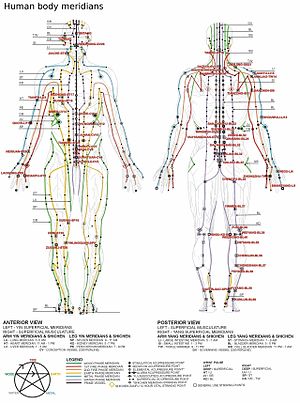
Acupuncture is a form of therapy derived from Traditional Chinese Medicine (TCM) involving the stimulation of points on the body with the use of needles, for therapeutic or preventative purposes. The points are derived from TCM theory and relate to the meridians, a system that purportedly allows the flow of ’Qi’ through the body, blockages of which are thought to cause health problems.
Disturbance of the flow of ‘Qi’ is believed to be the cause of disease or illness. Meridians are defined as the pathways within the body that transport Qi and blood. According to TCM theory, each meridian has its own function-specific points for curative purposes. There are 10 such points with Yuan (source) and Luo (connecting) being the points most commonly referred to. The Yuan points are closely related to the associated tissues and are believed to be the site where the primary Qi of an organ infuses. According to TCM concepts, pathological changes in an organ can manifest at the correlating Yuan point. Luo points are believed to connect interrelated meridians. Yuan and Luo points can be used independently or in combination for treatment of an organ-related disorder.
Modulation of the lung acupressure points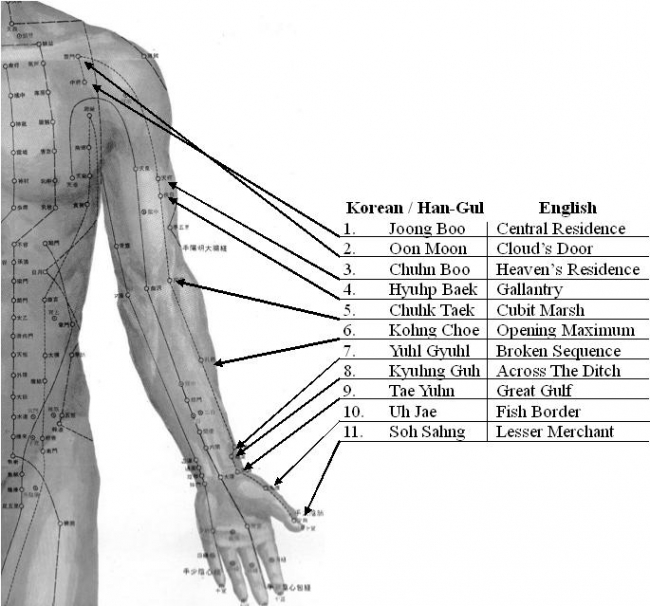
According to TCM practices, asthma is controlled by needling the LU 7 and LU 9 acupoints. The LU 7 is a commonly used point for management of lung disease such as asthma while the LU 9 is needled in certain cases. The LU 7 point comes very close to the cephalic vein and hence extreme caution must be taken while needling similarly, the brachial artery is proximal to the LU 9 point.
Scientific basis (a western perspective)
This method targets the area in the wrist, Chinese practitioners believe that Qi flow is through the lung meridians and needling these acupoints, removes blocks and enhances the Qi flow to the lungs. One of the major nerve system, called the ulnar nerve serves this area and needling this area may cause a release of calcium ions from the cells and this in-turn could result in a reflex action and causing a cascade of actions resulting in clearing the lung.
How many times do I have to do this and are there side effect?
The number of sessions required to cure asthma is subjective, it depends on the kind of asthma the patient is suffering from. TCM practitioners believe that there are different types of asthma based on how and where the Qi energy is blocked. In the case of lung meridian blockages of Qi, 2-3 sessions over a period of a couple of months should be enough, for some patients, one session will suffice. After which, the patient may show sings of the disease being under control and the number of asthma outbreaks may also reduce. There might be a relapse of the ailment and repeated sessions can cure the disease permanently.
What are the risks and other considerations?
There are no side effects to this kind of therapy, but caution must be taken while needling, and care must be taken to avoid ulnar and radial arteries. Most practitioners are aware of this and cautious. Some practitioners ask the patients to avoid cold beverages and citrus juices.
Needling the stomach meridian points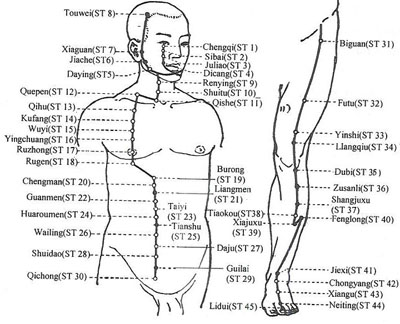
The stomach meridian points are shown in the figure and the ST-12 to ST-18 points and needled for treating asthma with the exception of ST-17, these points are located between the clavicle and rib cage. In order to reduce the phlegm associated with asthma, the ST-40 is at times targeted.
Scientific basis (a western perspective)
The Qi flow emanating from the stomach meridian can get blocked resulting in the accumulation of phlegm in the lungs. This block, according to TCM can be removed by needling the points mentioned above. Studies have not established any concrete basis of this TCM belief, but these acupoints have been used not only to treat phlegm but also ailments like epilepsy.
How many times do I have to do this and are there side effects?
As with all TCM cures, the duration of therapy is very subjective, in general to ensure no relapse of asthma, practitioners, resort to needling for 10 weeks with one session per week.
Some people report mild gastric discomfort for a day following this technique. This may not be related the treatment at all. The side effect is minor and seems to happen only to very few people.
What are the risks involved and other considerations?
No serious risk factors have been reported for this method of needling. It may cause mild hematoma for some patients. For certain patients, some form of dietary restriction is imposed by the practitioner.
Needling the kidney acupoints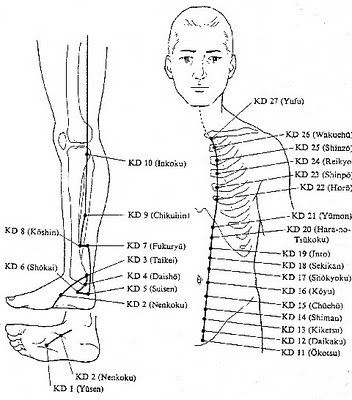
Kidney deficiency type asthma is caused by overwork or sexual indulgence which injures the kidneys. The main symptoms are dyspnea on exertion, severe wheezing and shortness of breath. A weakened kidney Qi is usually manifests as feeling cold at the extremities, the tongue turning pale and a weakening of the pulse. These can be easily treated by acupuncture and kidney deficient asthma is treated by needling the K3 and UB 23 acupuncture points.
Scientific basis (a western perspective)
This method is applied for acute asthma. This is thought to increase the Qi flow to the spleen. Western scientific studies have shown that needling these points enhance the immune system of the body. Spleen is a very important organ and enhances the immunity of a person.
How many times do I have to do this and are there side effects?
The time duration depends on the acuteness of the disorder and most TCM practitioners recommend a 10 weeks course with one sitting per week. There are no reported side effects.
What are the risks involved and other considerations?
Patients have not reported any risk and scientific studies have not indicated any risk factors. Some practitioners recommend not to use tomatoes during the period of the treatment and also long-term reduction of tomatoes in food preparations.
The bladder meridian points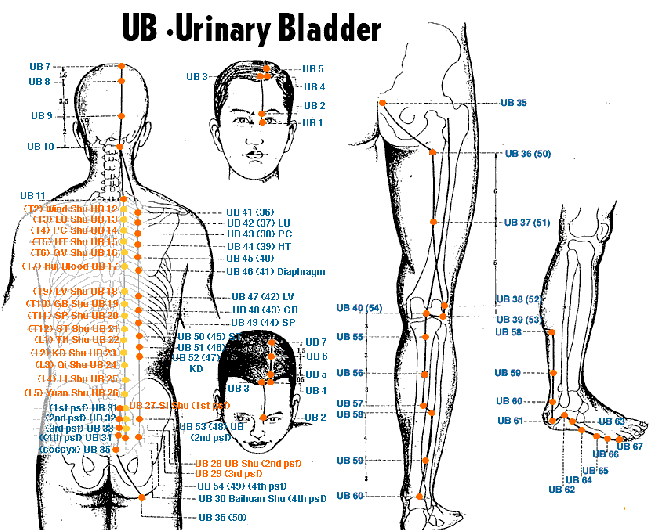
The bladder meridian points UB 13, UB 23 are commonly needled. These points have been commonly used by many TCM practitioners and have been documented to be effective in treating certain kinds of asthma and is generally used in acute cases of asthma.
Scientific basis (a western perspective)
It is known that interstitial fluids flow around the six meridian points prescribed in TCM and this has been demonstrated by magnetic resonance imaging (MRI). This could be one of the reasons why needling these points trigger a cascade of myo-neuronal stimulations.
How many times do I have to do this and are there side effects?
Acute cases of asthma need 10-12 weeks of treatment with one sitting per week. There are no known side effects to this therapy.
What are the risks and other considerations?
There are no known risks associated with this practice and some dietary restrictions may be imposed by the practitioner.
Combination of different points used to treat asthma
The points CV 17, LI 4, BL 13 and EX 14 are modulated. More recently, acupuncture stimulation over standard acupoints (BL 13, BL 17, LI 4, LU 7) and additional individualized points (LU 5, LU 6, ST 36, LI 3, KI 7, SP 6, SP 9, CV 6, CV 12, HT 7) have been utilized.
Scientific basis (a western perspective)
The immunoglobulin E has been reported to be affected and an increase in CD3+ and CD4+ and reduced levels of IL-6 and IL-10 along with eosinophils have been reported.
How many times do I have to do this and are there side effects?
Acupuncture stimulation for ten 20-minute sessions at the points CV 17, LI 4, BL 13 and EX 14 was associated with a reduction in IgE levels in patients with asthma. More recently, acupuncture stimulation over standard acupoints (BL 13, BL 17, LI 4, LU 7) and additional individualized points (LU 5, LU 6, ST 36, LI 3, KI 7, SP 6, SP 9, CV 6, CV 12, HT 7) for 12 sessions was reported to lead to increased levels of CD3+, CD4+ and IL-8, and reduced levels of IL-6, IL-10 and eosinophils. There are no reported side effects.
What are the risks and other considerations?
There are no known risks and many practitioners impose diet restrictions especially on cold beverages and soda.
Cupping therapy for asthma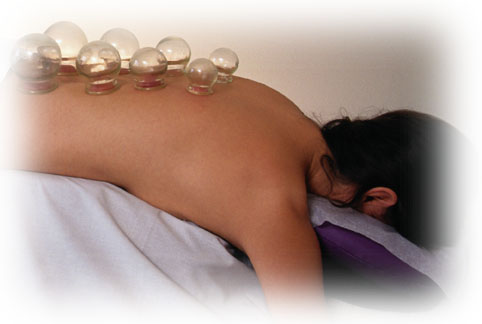
This is very similar to acupuncture but instead of a needle, the pressure points are modulated by placing a preheated cup. For asthma, the pressure points commonly used are GV-14, GV-12, BL-17, BL-15, BL-14, BL-13, BL-12, BL-11, CV-22, CV-17,CV-20, and LU-1.
Scientific basis (a western perspective)
It has been demonstrated from magnetic resonance imaging (MRI) that 361 acupoints used in TCM are located in connective tissues. The points mentioned above also fall under this category and stimulation of these tissues can result in muscle spasm and causing a series of biochemical reactions at the cellular level.
How many times do I have to do this and are there side effects?
Acute cases of asthma need 10-15 weeks of treatment with one sitting per week. There are no known side effects to this therapy.
What are the risks and other considerations?
There are no known risks associated with this practice and no diet restrictions are generally imposed.
There are no reported side effects associated with the application of acupuncture or cupping stimulation. However, there were reported complications associated with the acupuncture technique. The commonly reported injures are stab wounds inflicted due to the inexperience of the practitioner. Minor complications such as infection to the wounded sites or minor hematoma have also been reported. With adequate sterilization of the needles using 70% isopropanol alcohol, this problem can be resolved.




